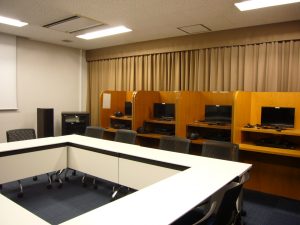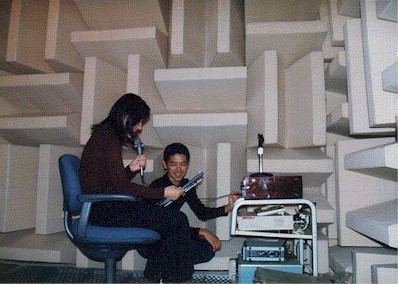Academic Facilities
The research building (currently, Language and Culture Building A) of the Graduate School of Language and Culture was completed in 1994. The various equipment and facilities required for research and education in language and culture are installed in the interior of the building, with such rooms as Advanced Visual Media Laboratory A (formerly the Satellite Broadcast and Reception Room) where TV footage broadcasted from around the world is received, the Anechoic Room for audio experiments, Advanced Visual Media Laboratory B (formerly the Advanced Visual Media Laboratory) used for seminars focusing on audio-visual materials, and the Computer Laboratory where computers are used to process language or audio data. The Multimedia Language Laboratory is being used as a facility of the Foreign Language Education and Research Division.
Advanced Visual Media Laboratory A (Mini Cinema A) (Formerly the Satellite Broadcast and Reception Room)
The Satellite Broadcast and Reception Room on the sixth floor of Language and Culture Building A was refurbished at the end of 2014. Not only were the CRT monitors for viewing satellite broadcasts replaced withliquid crystal monitors, but a projector (EPSON EB-1985WU 4800lumens) and screen were also installed. Because this also made it possible to use it as a room for projecting video teaching materials, it has been utilized in graduate school lessons from June of 2015 as the second Advanced Visual Media Laboratory (capacity of about 10 people) of the Department of Language and Culture. The name was changed from the “Satellite Broadcast and Reception Room” to Advanced Visual Media Laboratory A (Mini Cinema A).

Anechoic Room
Since it can eliminate noise from the surrounding area, this is the optimal room for speech perception experiments or sound recording. The characteristics of speech perception are also important in foreign language education, and effective foreign language learning is possible if one knows the features of sounds in foreign languages and strategies of Japanese speech perception. It is a facility that will assist in the transition from foreign language education that overemphasizes training in reading and writing skills to multimedia education that cultivates students’ perception of sounds.

Advanced Visual Media Laboratory B (Mini Cinema B) (Formerly the Advanced Visual Media Laboratory (Mini Cinema))
The Advanced Visual Media Laboratory was established on the third floor of Language and Culture Building B in 1999, and it has mainly been used as a room for projecting video educational materials in the classes of the Department of Language and Culture. After receiving discretionary expenses from the university president in 2003, its basic capabilities were greatly improved along with the establishment of a digital environment, and the nickname of “Mini Cinema” was born. Due to the opening of the new “Advanced Visual Media Laboratory A (Mini Cinema A)” on the sixth floor of Building A in June of 2015, the name was changed to “Advanced Visual Media Laboratory B (Mini Cinema B).”
Although this is an era where it is easy to enjoy a home theater, and where classrooms with liquid crystal projectors are not uncommon, “Mini Cinema B” is unique in that it is equipped with facilities exclusively for projection. In this small classroom with a capacity of about 20 people, a screen brightness of 4500ANSI lumens and (for PC input) SXGA levels of resolution can be achieved on the screen. Centered on a main speaker with a 25cm double-woofer, the 5.1 channel audio system boasts a sound quality just like that of movie theaters. Aside from PCs, other sources can be exhibited and played, such as VHS (all regions), DVD (all regions), DVD-R/RAM, miniDV, and LD. Furthermore, it is also equipped with augmentability for the new media of the future. Operation through the system controller is simple, and anyone can operate it. Further, it is also possible for data from any source to be incorporated into a PC and freely edited and processed.
In the current “Mini Cinema B,” classes that use video such as introduction to foreign cultures, history of film and video, and discourse analysis as well as screenings have all been conducted. As video analysis through mechanical processing and presentation techniques using video develop further, it is certain that the importance of the role that audio-visual texts fulfill in research of language and culture will increase more and more. It is expected that now and in the future, “Mini Cinema B” will respond to such educational and research needs of the Department of Language and Culture.
Incidentally, some of the departmental budget and the discretionary expenses from the university president were used for the software aspect as well, and the archive of audio-visual materials such as DVDs have been substantially enhanced.
Computer Laboratory
Room 307 (Digital Humanities Laboratory)
Computers
Server System:
- ・Two Apple Xserves running 2.26GHz Quad-Core Xeon processors with a RAID
backup system: AFP file sharing service/LDAP authentication service - ・Apple iMac 2.5GHz Core i5 running BNC web, a Web interface to the British
National Corpus
Client System:
18 Apple iMacs with a 21.5” HD widescreen (CPU: 2.8GHz Core i5)
Software applications/Tools/Corpora available on the client computers:
Apple application suite: Keynote, Pages, Numbers; Microsoft Office for Mac; TextWrangler; CotEditor; oXygen XML editor; CLAWS4 automatic part-of-speech tagging system; TreeTagger; CasualMecab (Japanese morphological analysis interface); DocuScope (Tool for Computer-aided Rhetorical Analysis); MALLET (MAchine Learning LanguagE Toolkit); The R language environment for statistical computing and graphics; MacR (GUI frontend for the R language); CasualConc (concordancing and data visualization software suite); CasualTagger (GUI frontend for POS tagging); CasualTranscriber (utility program to assist transcription of audio/video texts); LaTeX (high-quality typesetting and document preparation system); MySQL (database server); Corpus of Contemporary American English (COCA); Corpus of Historical American English (COHA); GloWbE (Corpus of Global Web-Based English); BNC (British National Corpus); ICAME Corpus Collection 2
High Definition Document Scanners
MINOLTAEPCWIN7000
The ScanSnap SV600
Room 502, Room 607
Computers
There are 18 Windows 7-model client machines installed in Room 502, and 12 installed in Room 607. Starting with Microsoft Office, an environment for basic file viewing or editing is in place. User management such as domain participation and file sharing are performed on the Windows server.
Digital Multifunction Machine
A Fuji Xerox ApeosPort-V C7780 is installed in Room 502.
Multimedia Language Laboratory
The Graduate School of Language and Culture is using three LL (Language Laboratory) Classrooms and one LL Editing Room as facilities of the Foreign Language Education and Research Division. Devices are installed in the LL Classrooms, such as audio and video devices, equipment for presenting educational materials, and DVDs.
LL Classroom
Each classroom is of open style, with no partition walls between booths, and all classrooms are installed in CELAS Building A on the second floor (Classroom 204 and 205) and the third floor (Classroom 305). Each has 60 booths, and every booth is equipped with a cassette recorder. Four booths have TV monitors suspended from the ceiling, and multiscreen, audio equipment (cassette tape, CD, MD) and video equipment (VHS, DVD) can all be used. The master control (the control podium for the teacher) is equipped with a camera for projecting original teaching materials, and an internal microcomputer for aggregating and analyzing results.
LL Editing Room
Management of LL Classroom equipment and teaching materials is conducted in the LL Editing Room, as well as audio and video editing. It is equipped with all varieties of audio and video equipment. Although teaching materials and classes are prepared here, the types of teaching materials made use of—other than commercially available software—range from TV news and documentaries (including satellite broadcasts) to foreign-language movies or bilingual movies in Japanese and other languages.
